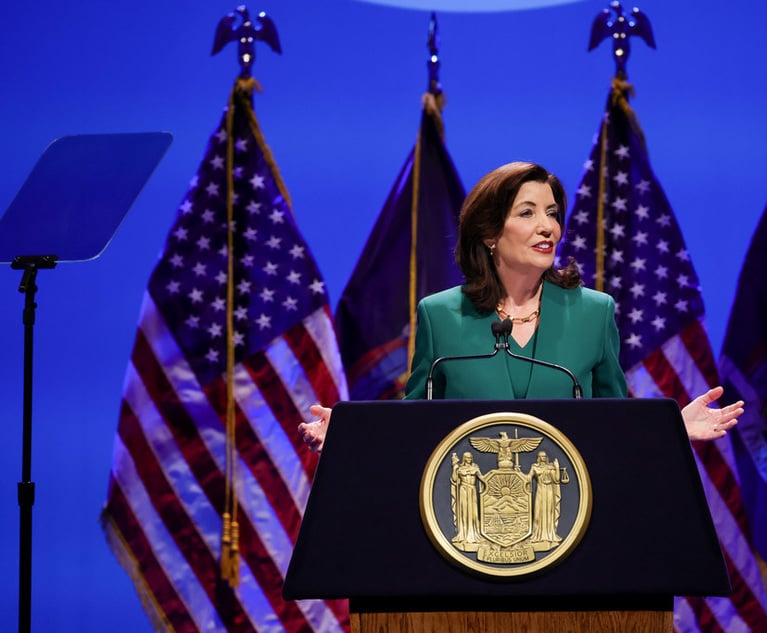Long Island, Mid-Hudson Law Firms Cleared to Reopen Offices
Gov. Andrew Cuomo says the Mid-Hudson region moved into phase two on Tuesday and experts have cleared Long Island to begin the phase starting Wednesday.
June 10, 2020 at 12:15 PM
3 minute read
 Modern pier with "Long Island" painted on it in Gantry Plaza State Park, Queens, New York.
Modern pier with "Long Island" painted on it in Gantry Plaza State Park, Queens, New York.
Law firms on Long Island and in the Mid-Hudson region have been cleared to reopen their offices after months of business restrictions due to the COVID-19 pandemic, according to Gov. Andrew Cuomo.
In-office positions have been approved to come back in those regions, according to state officials who say key COVID-19 figures are down overall in those areas. Office positions are allowed back under phase two of the state's economic reopening plan, which also allows for real estate services, in-store retail shopping and "limited" hair salon and barbershop services.
Cuomo says the Mid-Hudson region moved into phase two on Tuesday and experts have cleared Long Island to begin the phase starting Wednesday.
New York City, hard hit by the pandemic, still remains in phase one of the reopening scheme, which places stricter restrictions on which businesses are allowed to open compared to phase two.
Like many states across the nation, New York issued lockdown measures as a way to blunt the virus' spread. Officials in general have been forced to balance reopening decisions with the possibility of COVID-19 outbreaks.
At one point, New York's restrictions had ordered all nonessential employees to not come into their workplace. As the virus has waned, state officials have loosened the businesses restrictions on a regional basis.
Cuomo on Tuesday congratulated the Mid-Hudson region, which includes Westchester and Rockland counties.
"The numbers are down, because you brought the numbers down. [This is] not government action. It's not an act of God. It's an act of the people," the governor said. "They got disciplined. They got smart. They did what they had to do. They brought the numbers down."
For office-based work, the state has released guidelines for businesses navigating the coronavirus pandemic.
The guidelines recommended strict "clean-desk policies," along with modifying the number of workstations so that employees are at least six feet apart. The guidelines mandate the implementation of a health screening assessment for workers, which should include asking them about COVID-19 symptoms over the last two weeks.
READ MORE:
Moves Toward 'Soft' Reopening Underline Tensions, Frustration Over Return to Law Firm Offices
How Can Law Firms Safely Reopen? New York Bar Group to Make Recommendations
Law Firm Office Reopening Guidance: Wear Masks and Take Attendance
This content has been archived. It is available through our partners, LexisNexis® and Bloomberg Law.
To view this content, please continue to their sites.
Not a Lexis Subscriber?
Subscribe Now
Not a Bloomberg Law Subscriber?
Subscribe Now
NOT FOR REPRINT
© 2025 ALM Global, LLC, All Rights Reserved. Request academic re-use from www.copyright.com. All other uses, submit a request to [email protected]. For more information visit Asset & Logo Licensing.
You Might Like
View All
'Playing the Clock'?: Hochul Says NY's Discovery Loophole Is to Blame for Wide Dismissal of Criminal Cases

So Who Won? Congestion Pricing Ruling Leaves Both Sides Claiming Victory, Attorneys Seeking Clarification
4 minute read
Hochul Vetoes 'Grieving Families' Bill, Faulting a Lack of Changes to Suit Her Concerns

Court System Names New Administrative Judges for New York City Courts in Leadership Shakeup
3 minute readTrending Stories
- 1'A Death Sentence for TikTok'?: Litigators and Experts Weigh Impact of Potential Ban on Creators and Data Privacy
- 2Bribery Case Against Former Lt. Gov. Brian Benjamin Is Dropped
- 3‘Extremely Disturbing’: AI Firms Face Class Action by ‘Taskers’ Exposed to Traumatic Content
- 4State Appeals Court Revives BraunHagey Lawsuit Alleging $4.2M Unlawful Wire to China
- 5Invoking Trump, AG Bonta Reminds Lawyers of Duties to Noncitizens in Plea Dealing
Who Got The Work
J. Brugh Lower of Gibbons has entered an appearance for industrial equipment supplier Devco Corporation in a pending trademark infringement lawsuit. The suit, accusing the defendant of selling knock-off Graco products, was filed Dec. 18 in New Jersey District Court by Rivkin Radler on behalf of Graco Inc. and Graco Minnesota. The case, assigned to U.S. District Judge Zahid N. Quraishi, is 3:24-cv-11294, Graco Inc. et al v. Devco Corporation.
Who Got The Work
Rebecca Maller-Stein and Kent A. Yalowitz of Arnold & Porter Kaye Scholer have entered their appearances for Hanaco Venture Capital and its executives, Lior Prosor and David Frankel, in a pending securities lawsuit. The action, filed on Dec. 24 in New York Southern District Court by Zell, Aron & Co. on behalf of Goldeneye Advisors, accuses the defendants of negligently and fraudulently managing the plaintiff's $1 million investment. The case, assigned to U.S. District Judge Vernon S. Broderick, is 1:24-cv-09918, Goldeneye Advisors, LLC v. Hanaco Venture Capital, Ltd. et al.
Who Got The Work
Attorneys from A&O Shearman has stepped in as defense counsel for Toronto-Dominion Bank and other defendants in a pending securities class action. The suit, filed Dec. 11 in New York Southern District Court by Bleichmar Fonti & Auld, accuses the defendants of concealing the bank's 'pervasive' deficiencies in regards to its compliance with the Bank Secrecy Act and the quality of its anti-money laundering controls. The case, assigned to U.S. District Judge Arun Subramanian, is 1:24-cv-09445, Gonzalez v. The Toronto-Dominion Bank et al.
Who Got The Work
Crown Castle International, a Pennsylvania company providing shared communications infrastructure, has turned to Luke D. Wolf of Gordon Rees Scully Mansukhani to fend off a pending breach-of-contract lawsuit. The court action, filed Nov. 25 in Michigan Eastern District Court by Hooper Hathaway PC on behalf of The Town Residences LLC, accuses Crown Castle of failing to transfer approximately $30,000 in utility payments from T-Mobile in breach of a roof-top lease and assignment agreement. The case, assigned to U.S. District Judge Susan K. Declercq, is 2:24-cv-13131, The Town Residences LLC v. T-Mobile US, Inc. et al.
Who Got The Work
Wilfred P. Coronato and Daniel M. Schwartz of McCarter & English have stepped in as defense counsel to Electrolux Home Products Inc. in a pending product liability lawsuit. The court action, filed Nov. 26 in New York Eastern District Court by Poulos Lopiccolo PC and Nagel Rice LLP on behalf of David Stern, alleges that the defendant's refrigerators’ drawers and shelving repeatedly break and fall apart within months after purchase. The case, assigned to U.S. District Judge Joan M. Azrack, is 2:24-cv-08204, Stern v. Electrolux Home Products, Inc.
Featured Firms
Law Offices of Gary Martin Hays & Associates, P.C.
(470) 294-1674
Law Offices of Mark E. Salomone
(857) 444-6468
Smith & Hassler
(713) 739-1250






